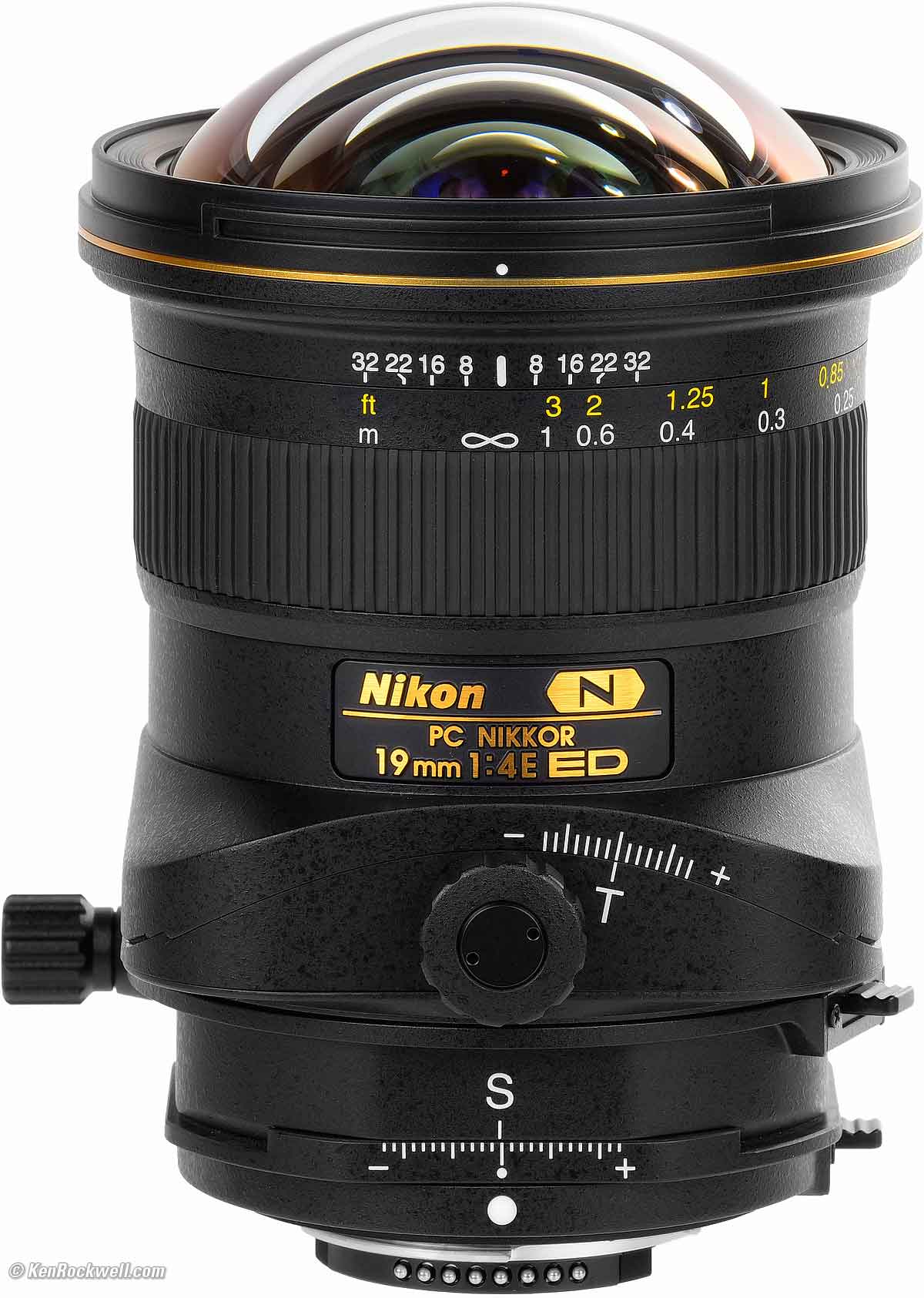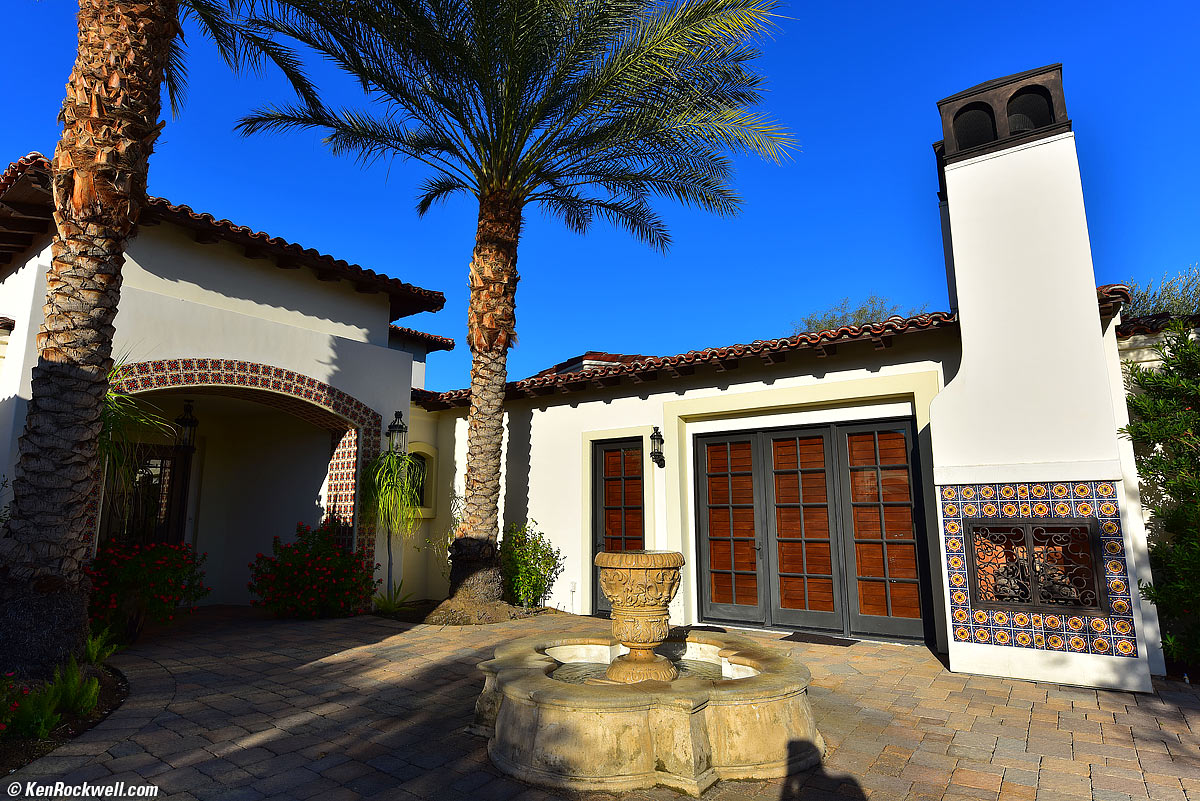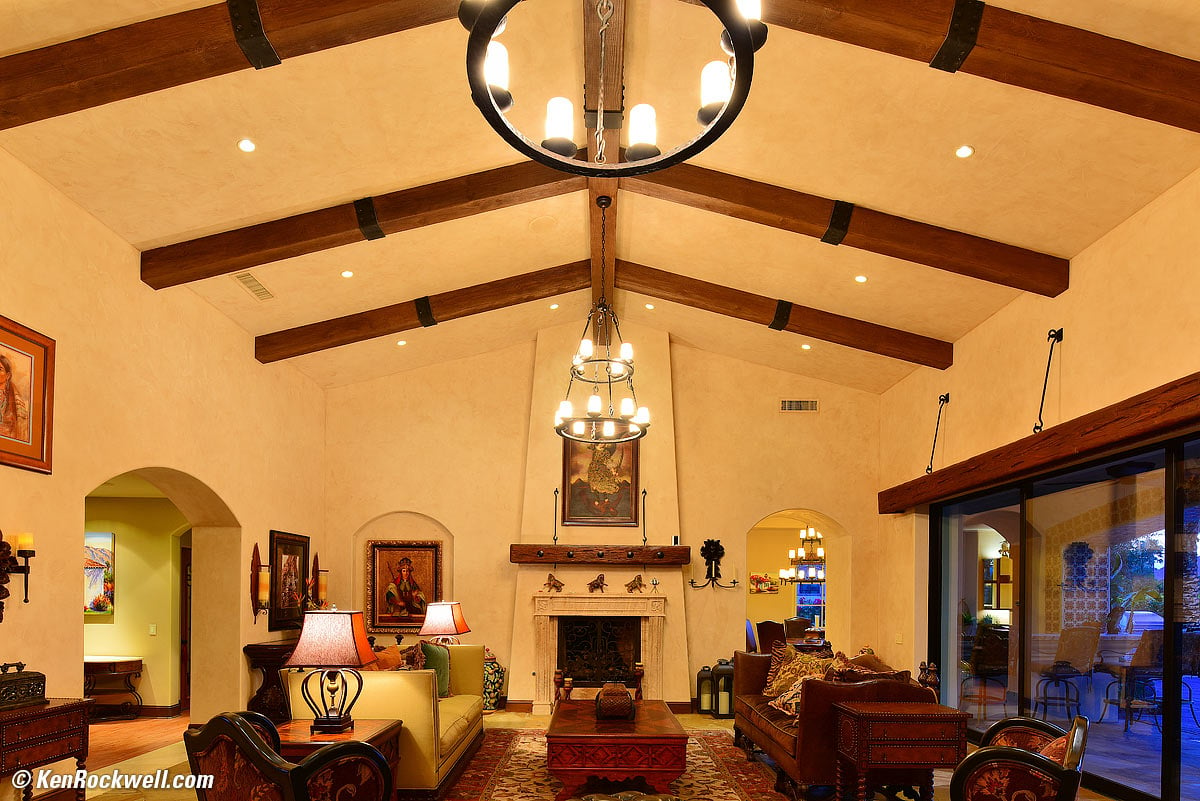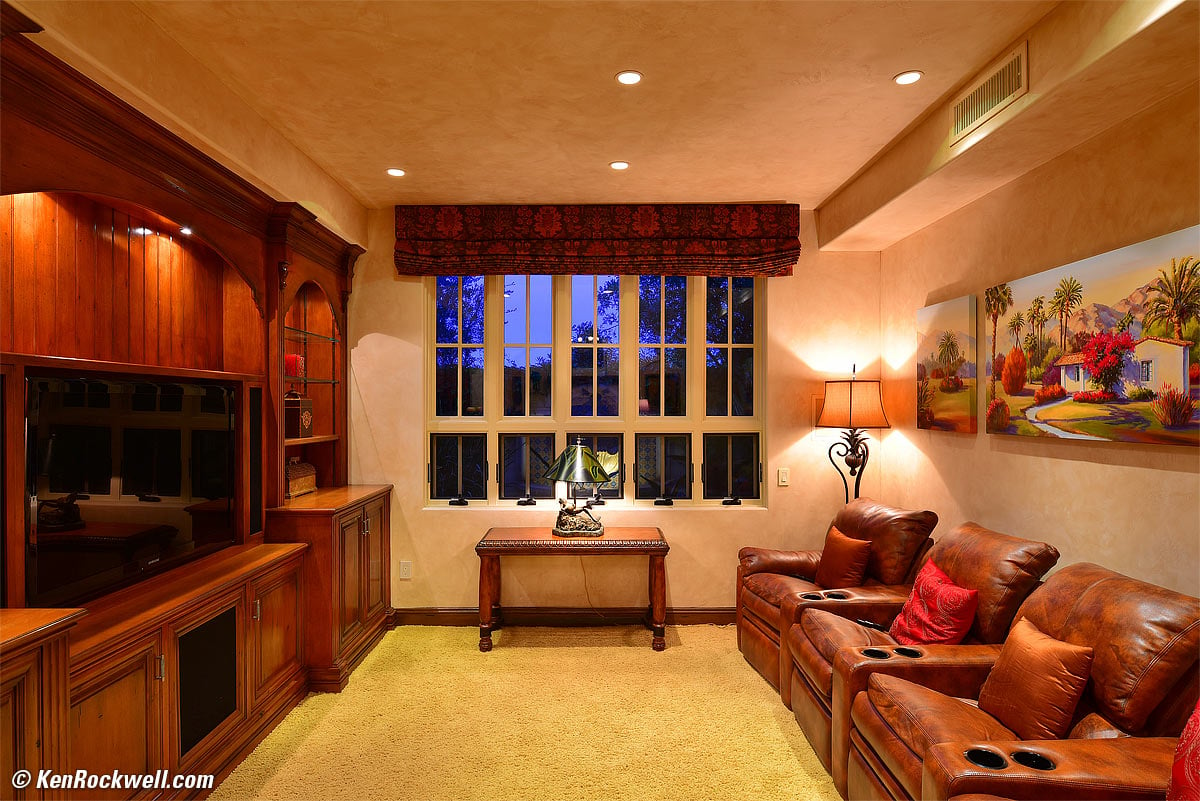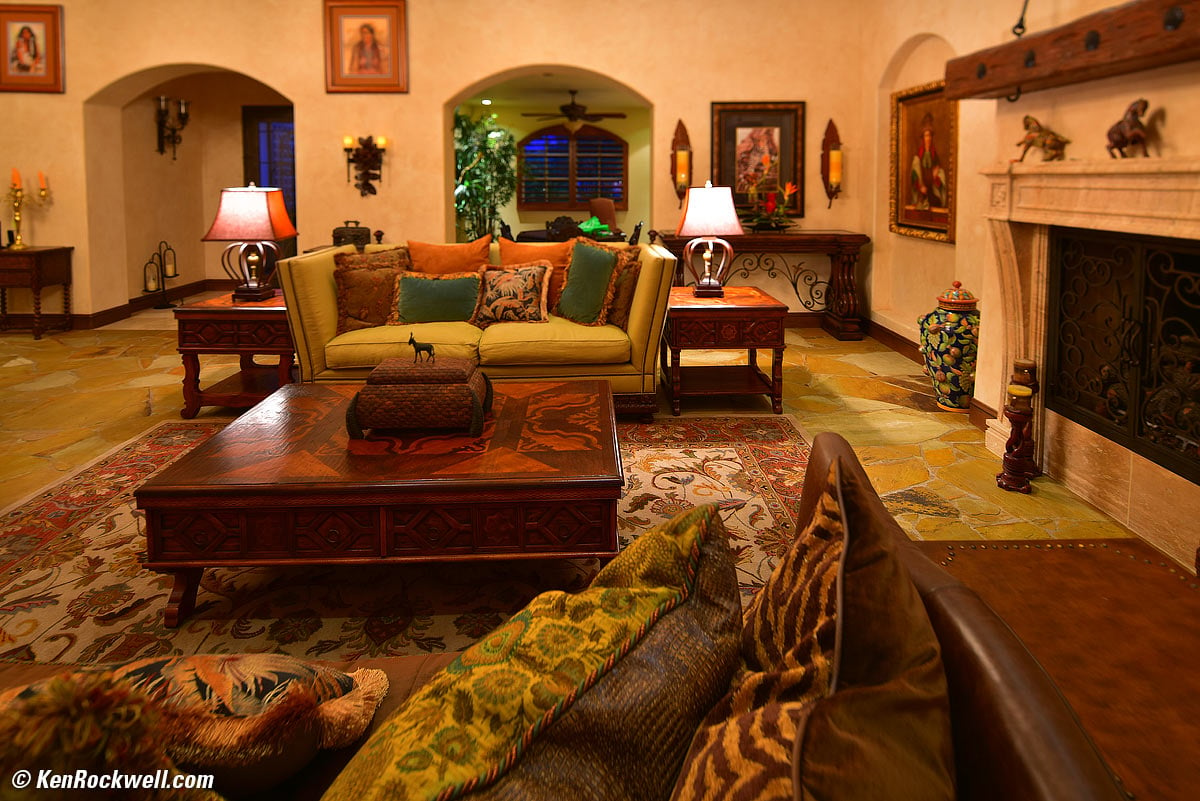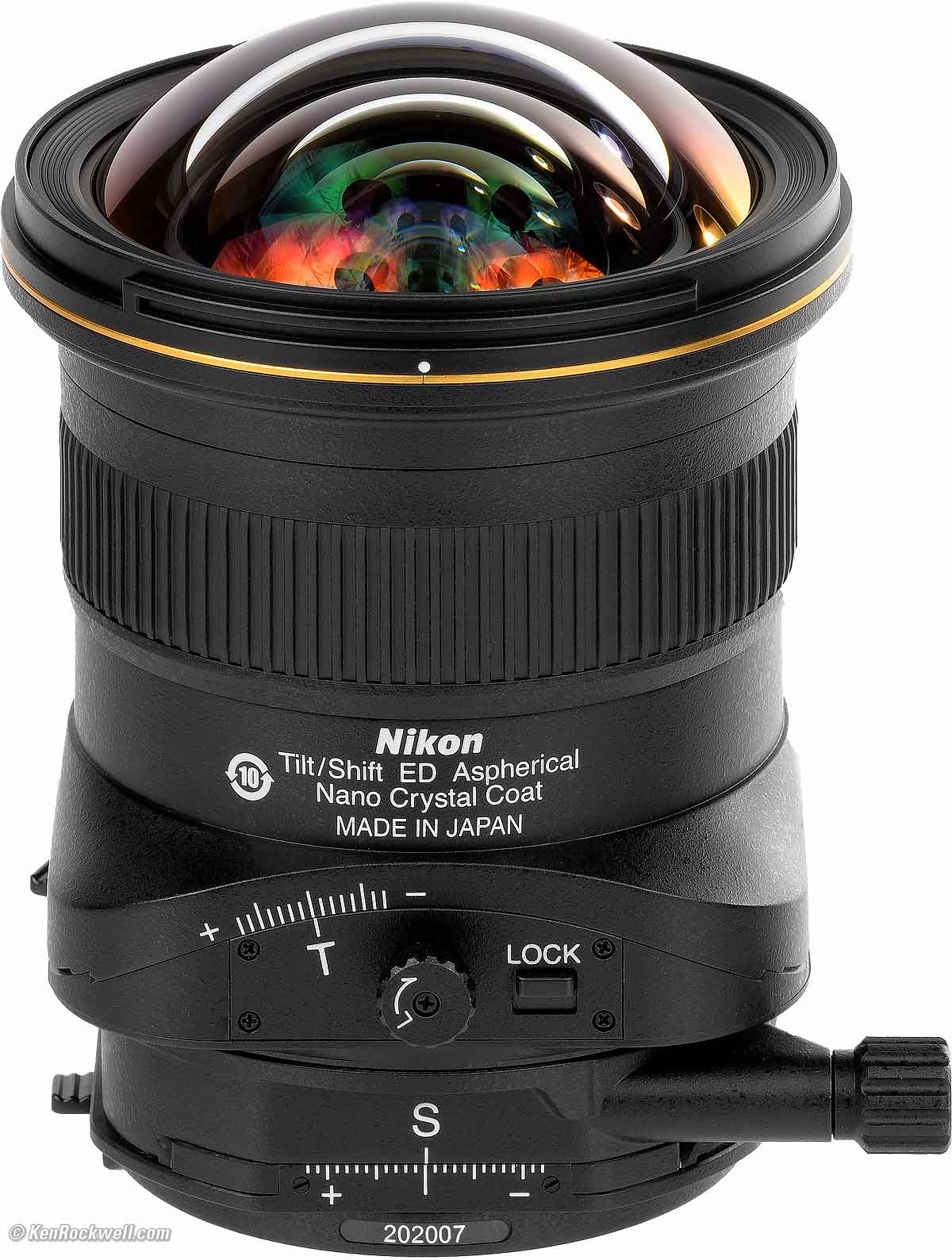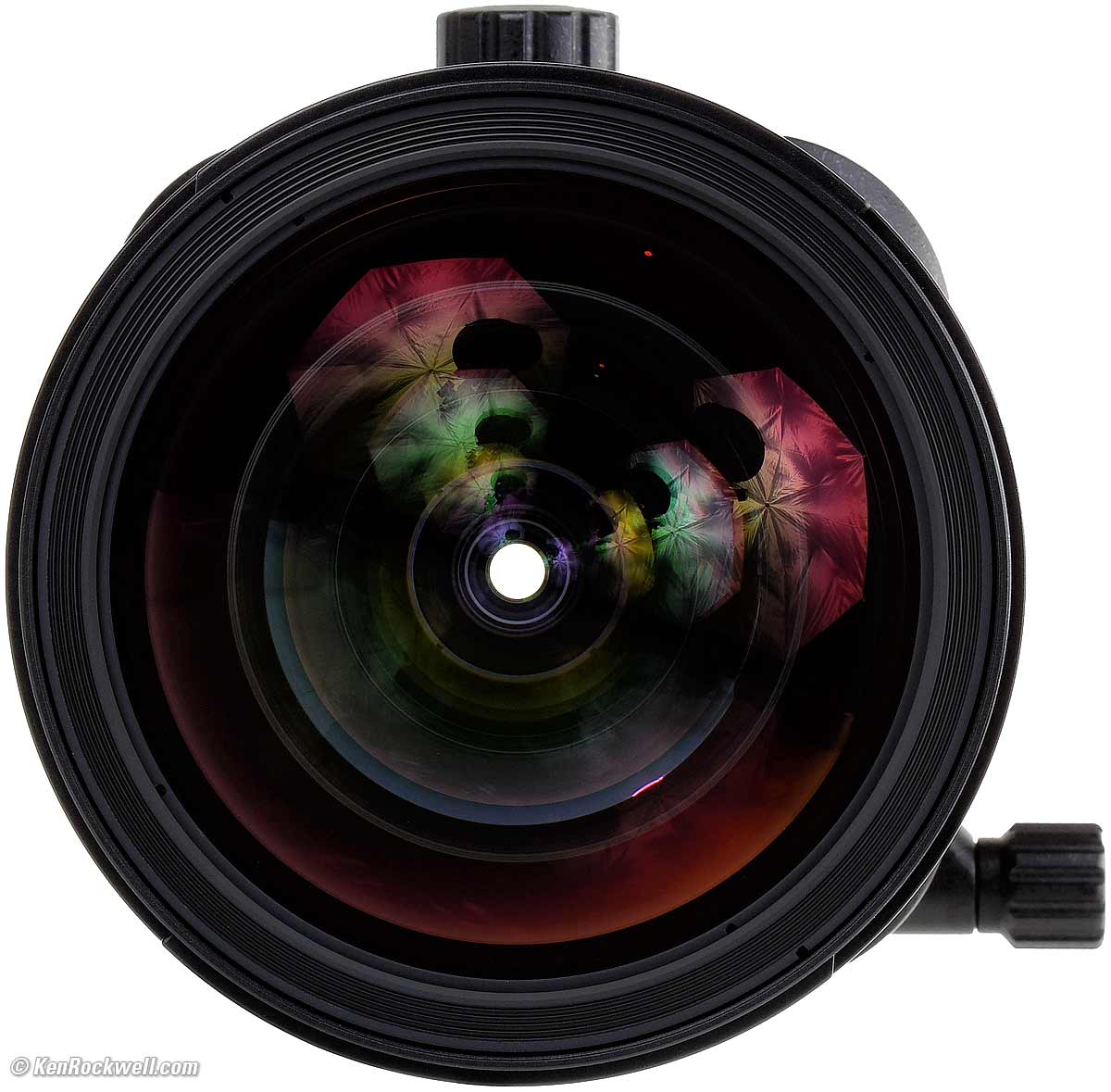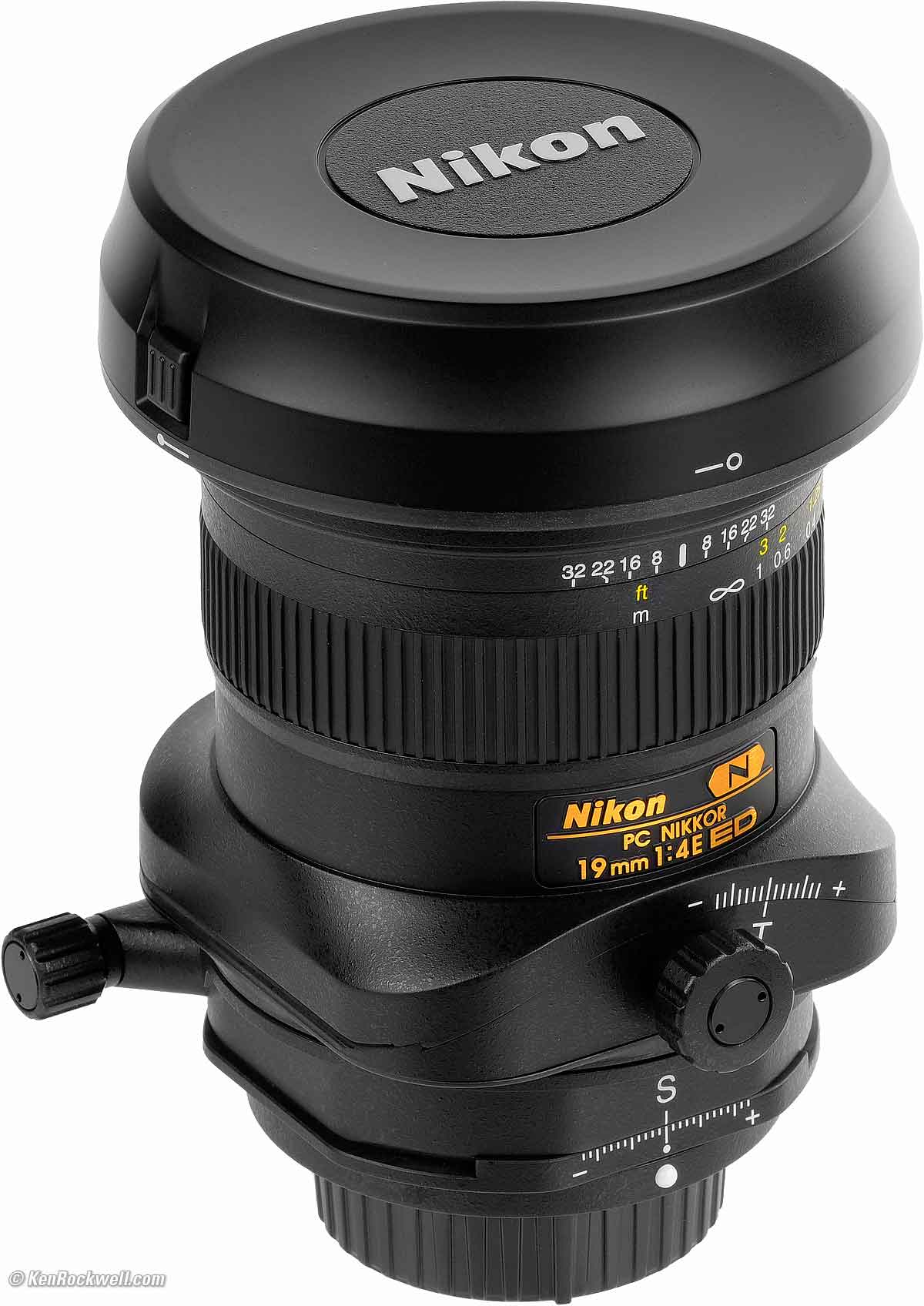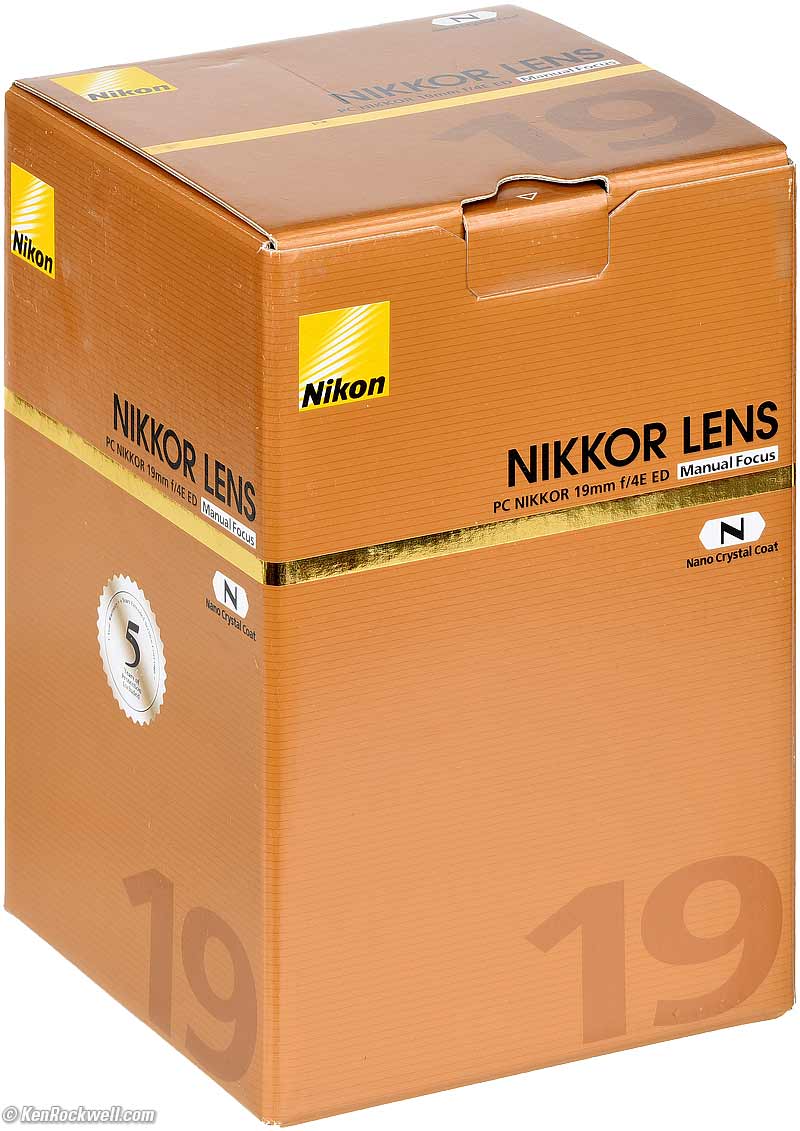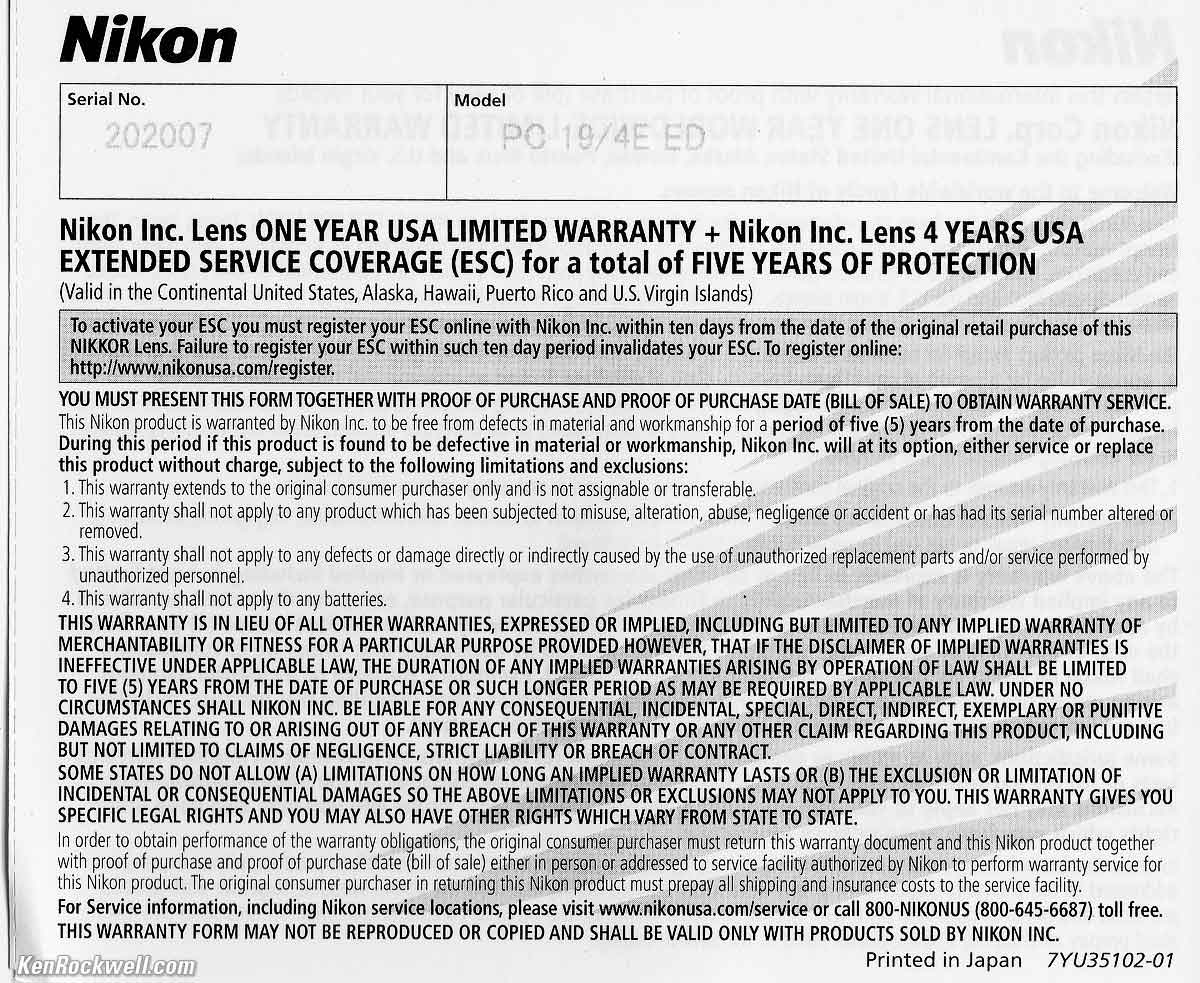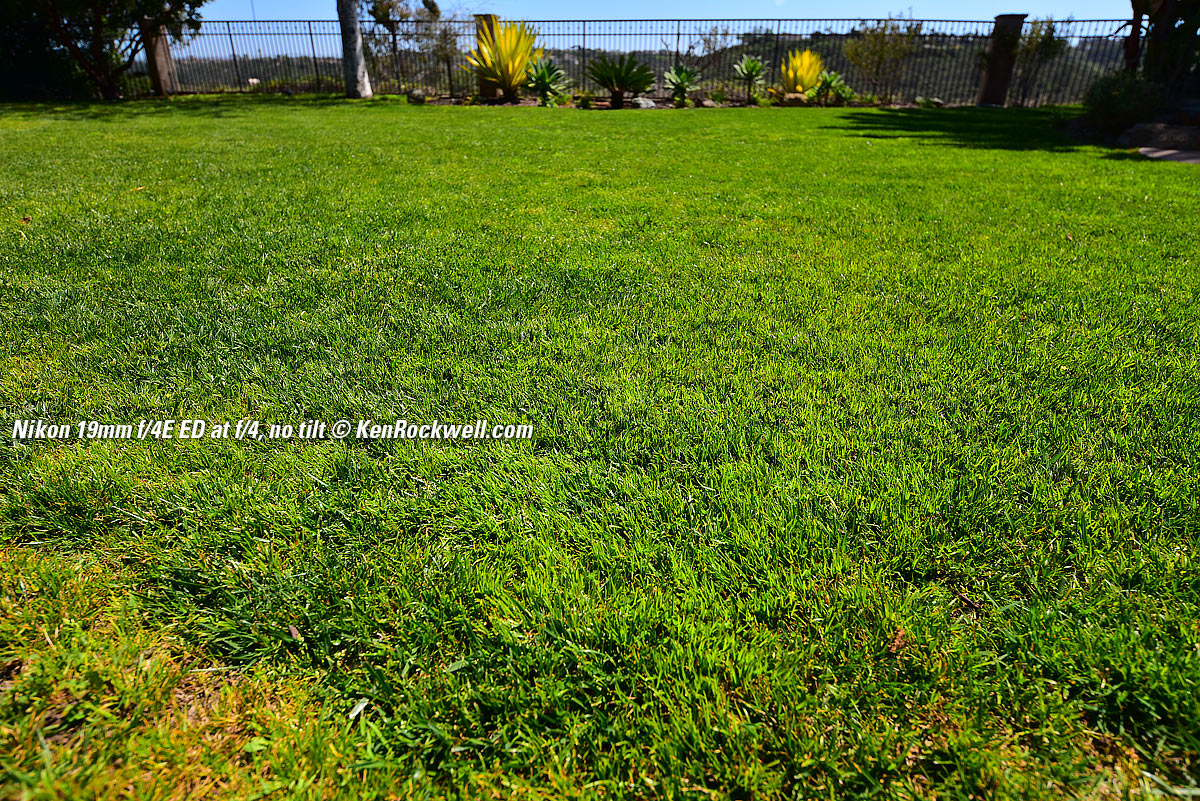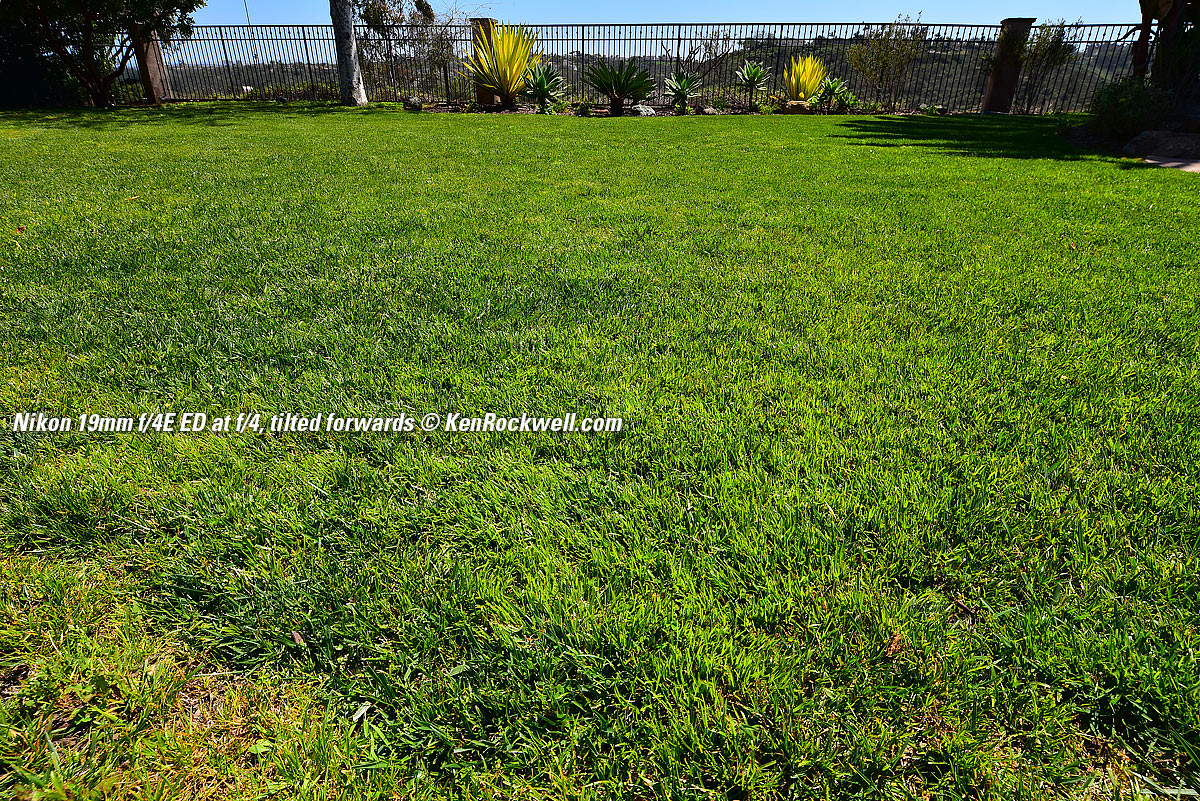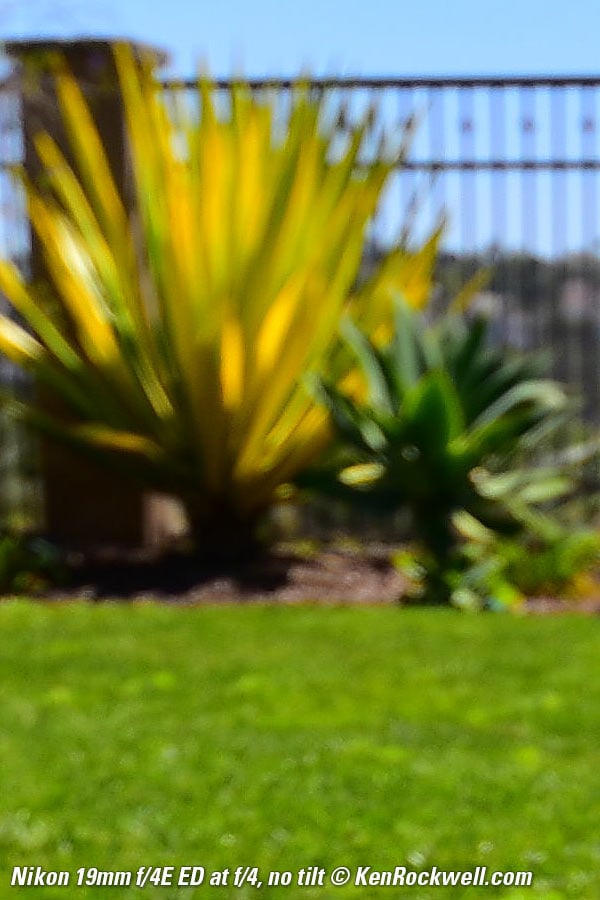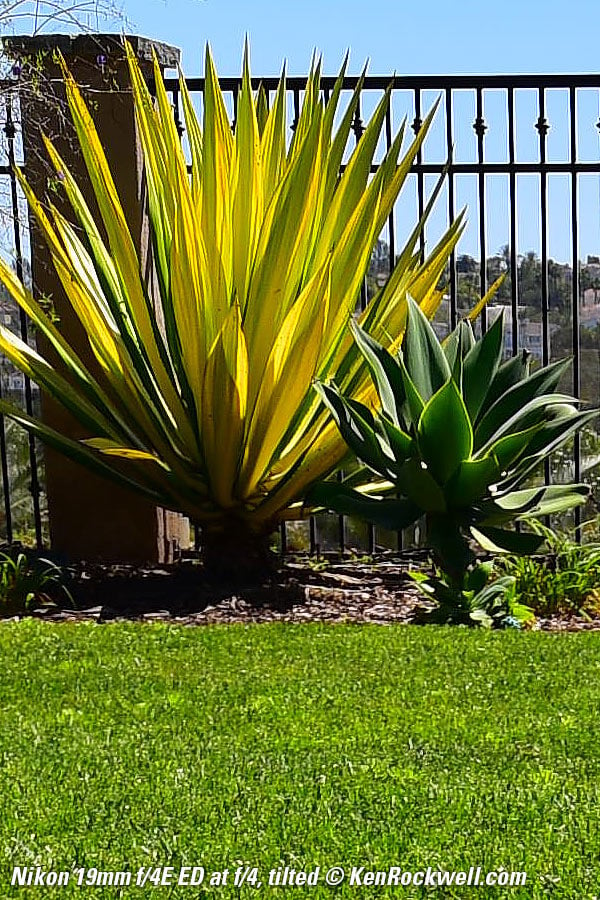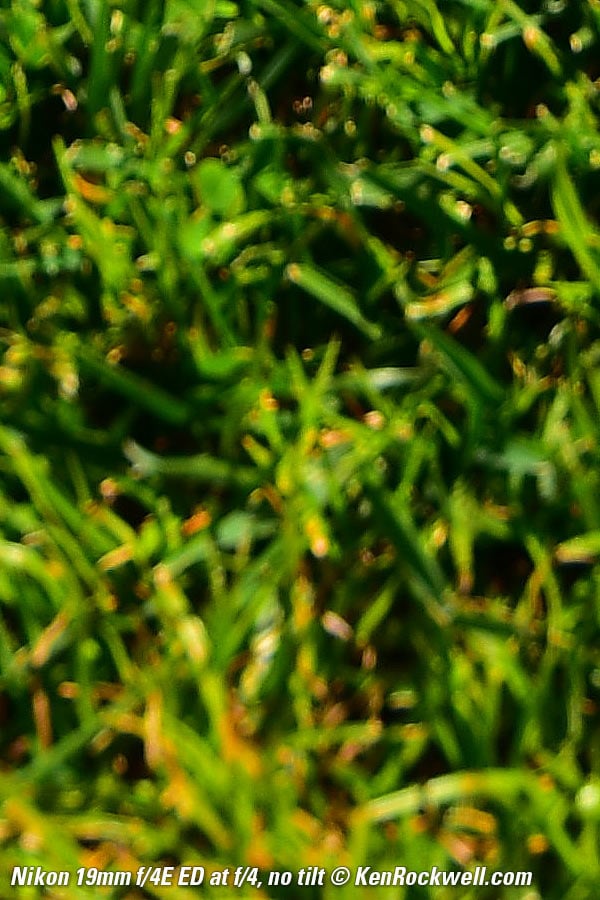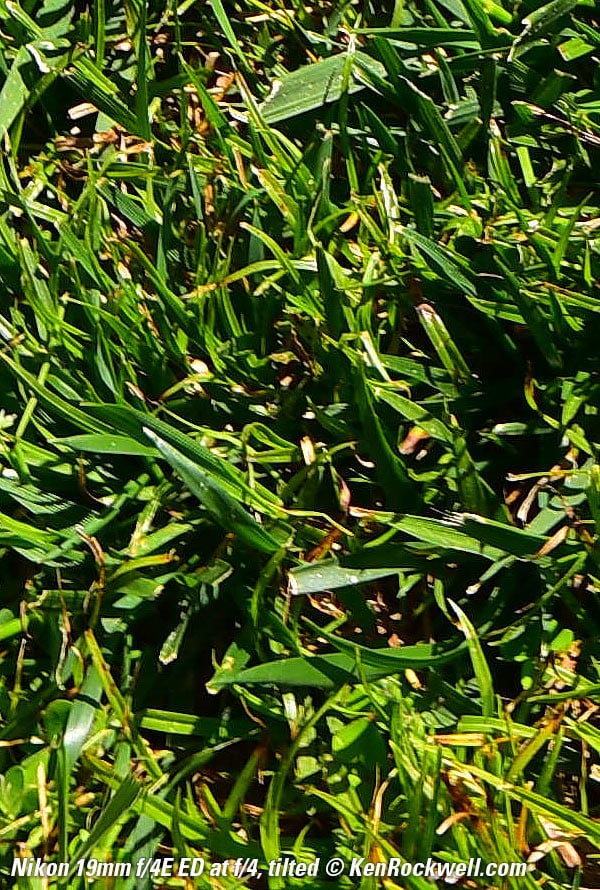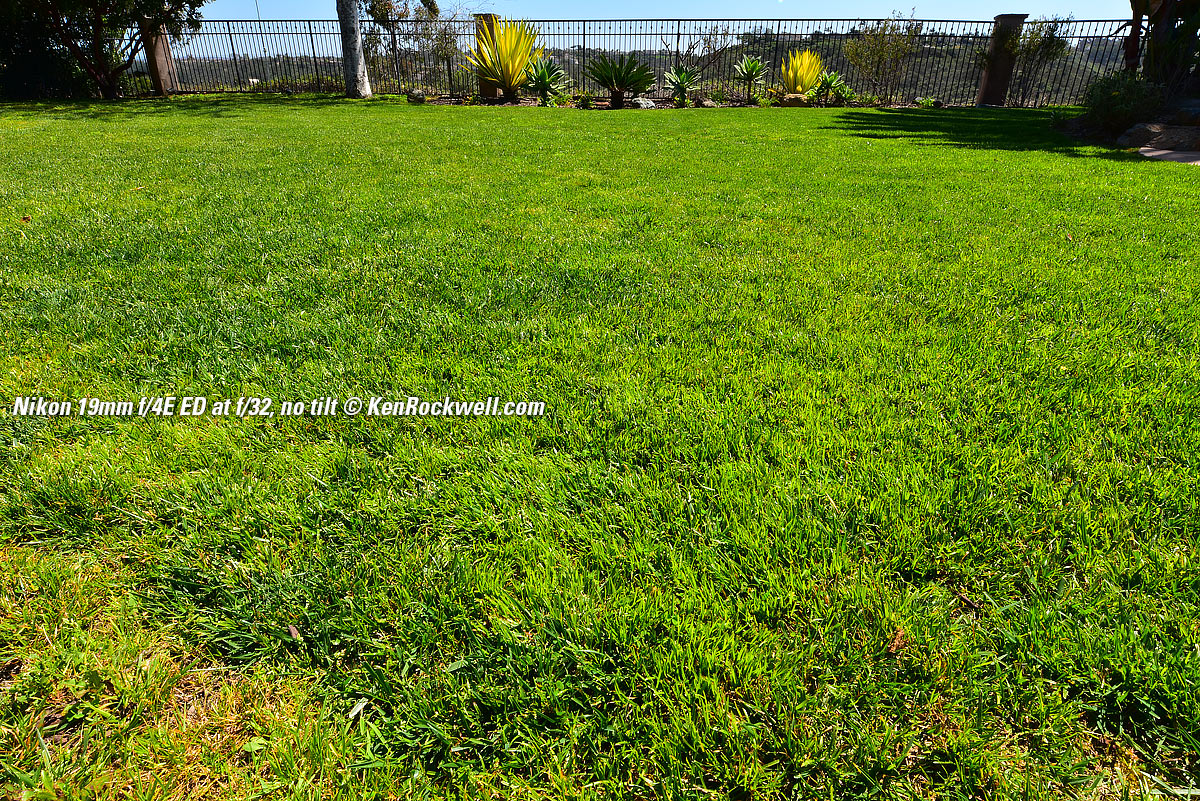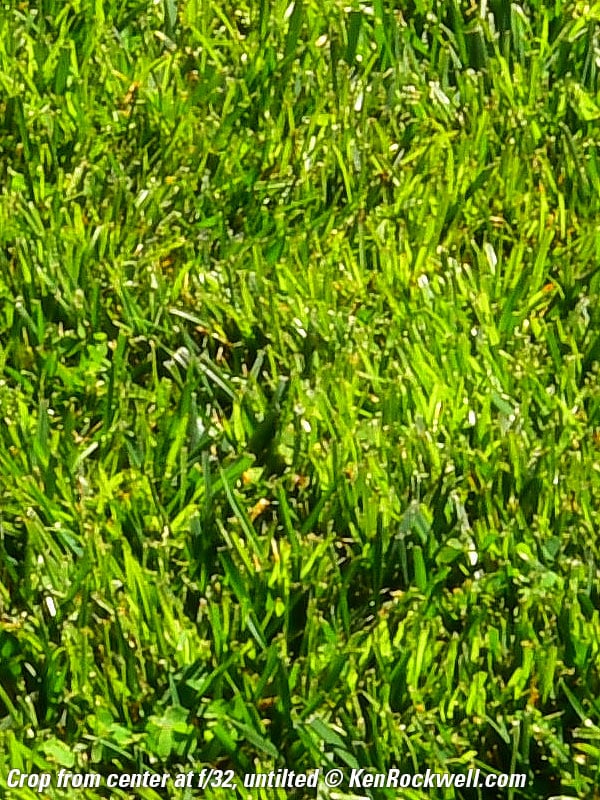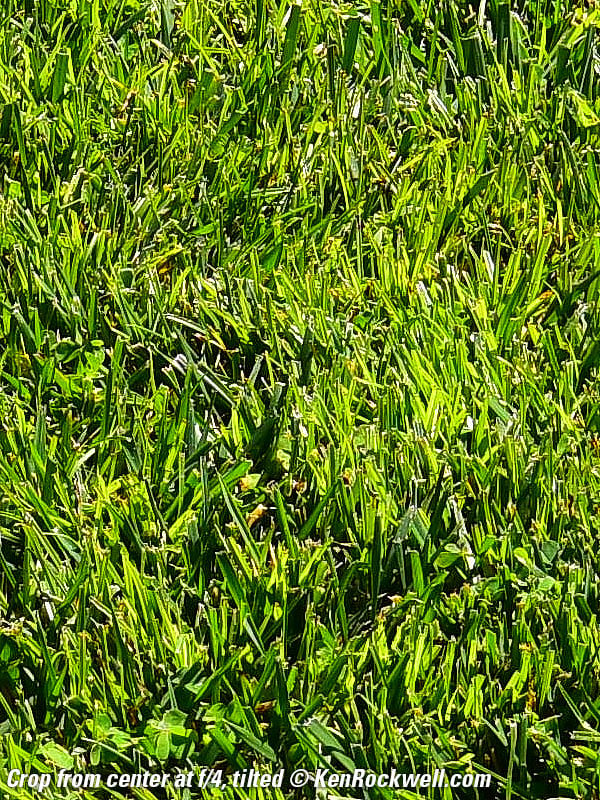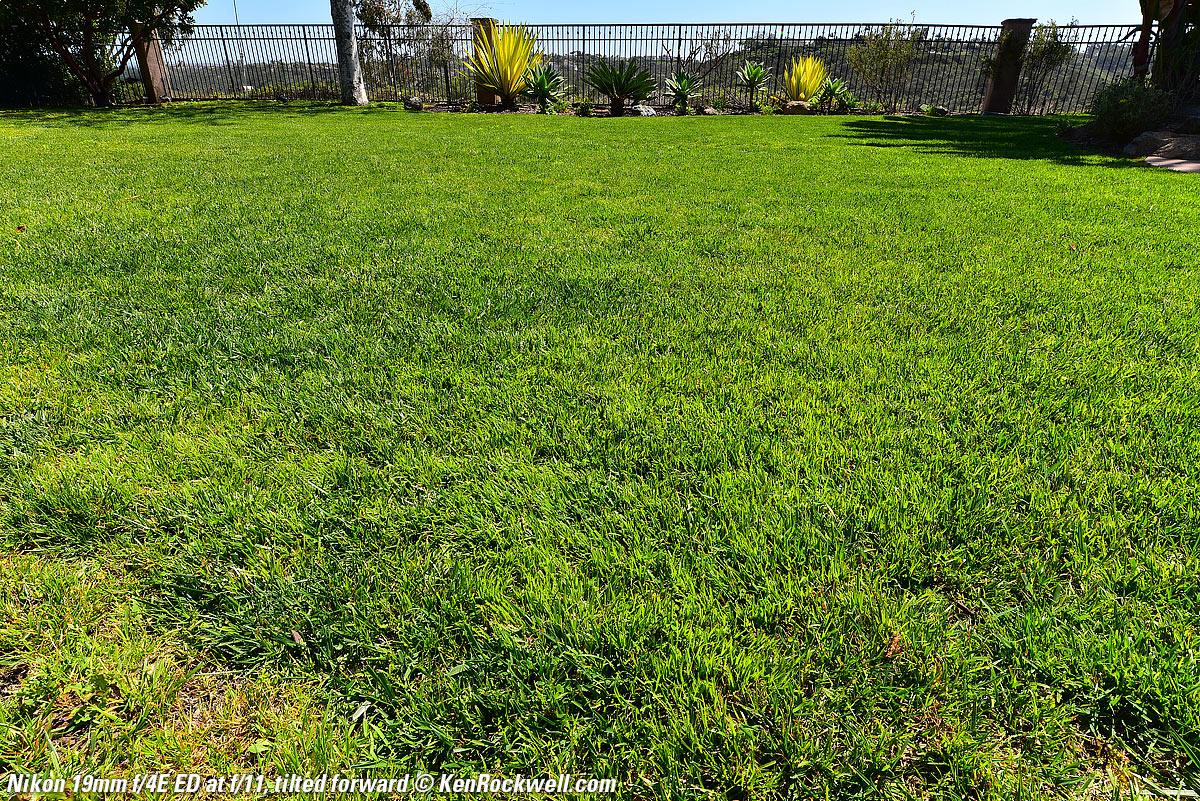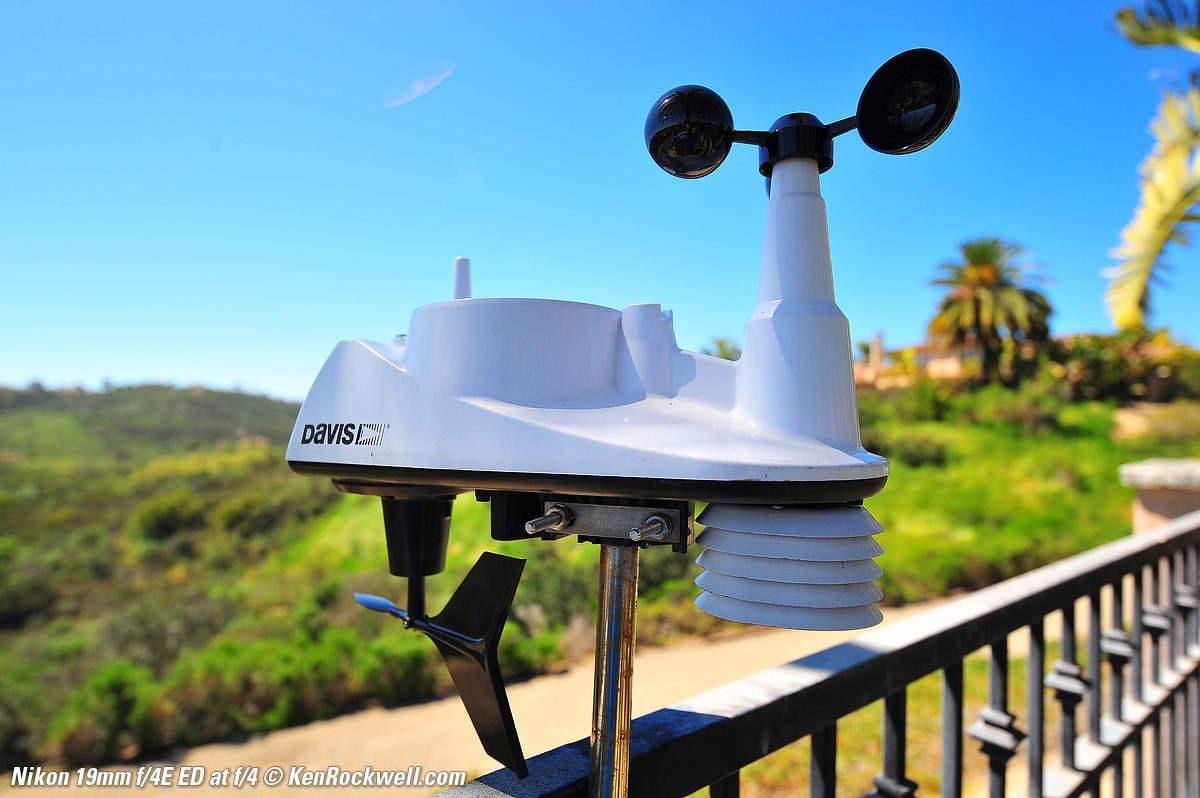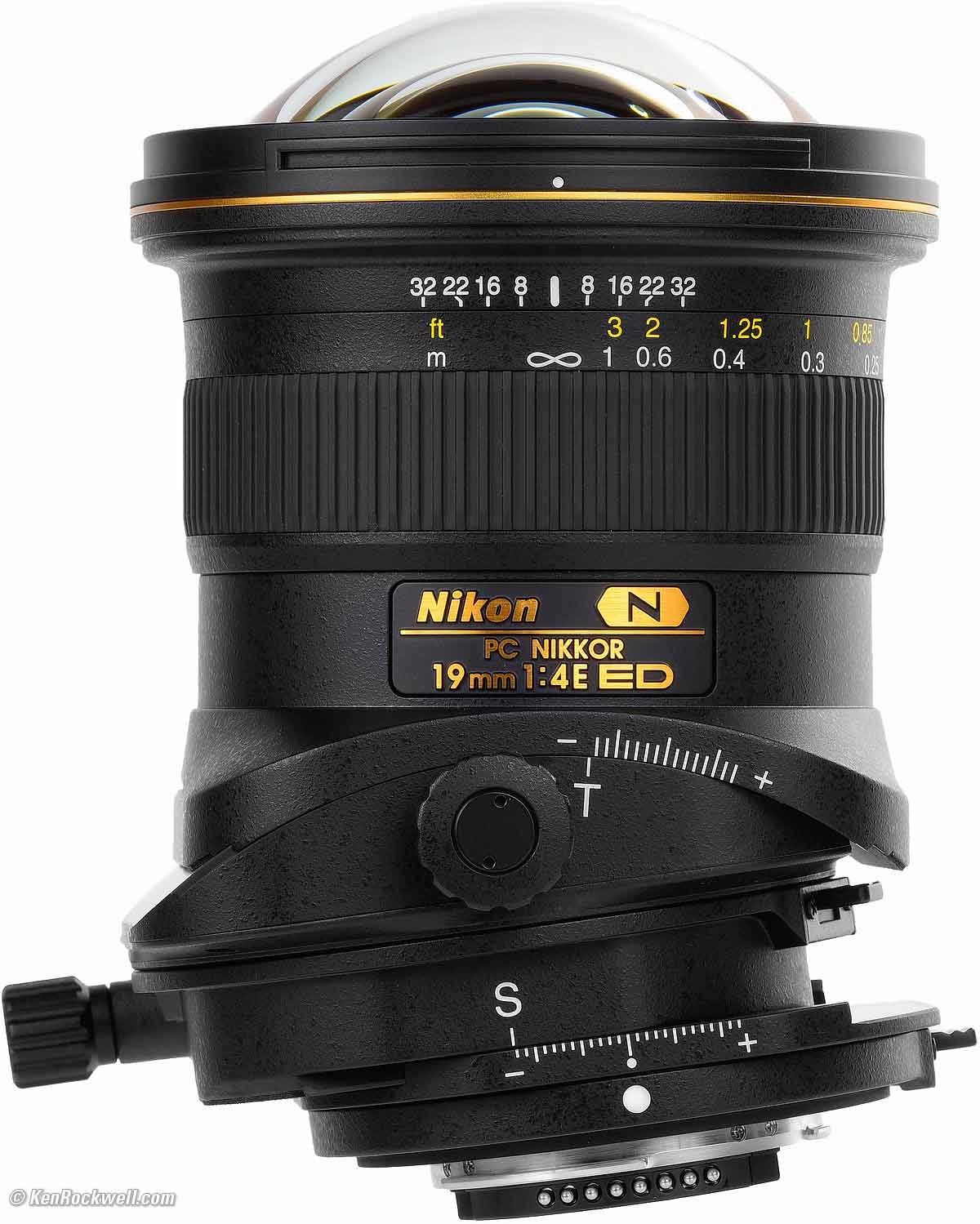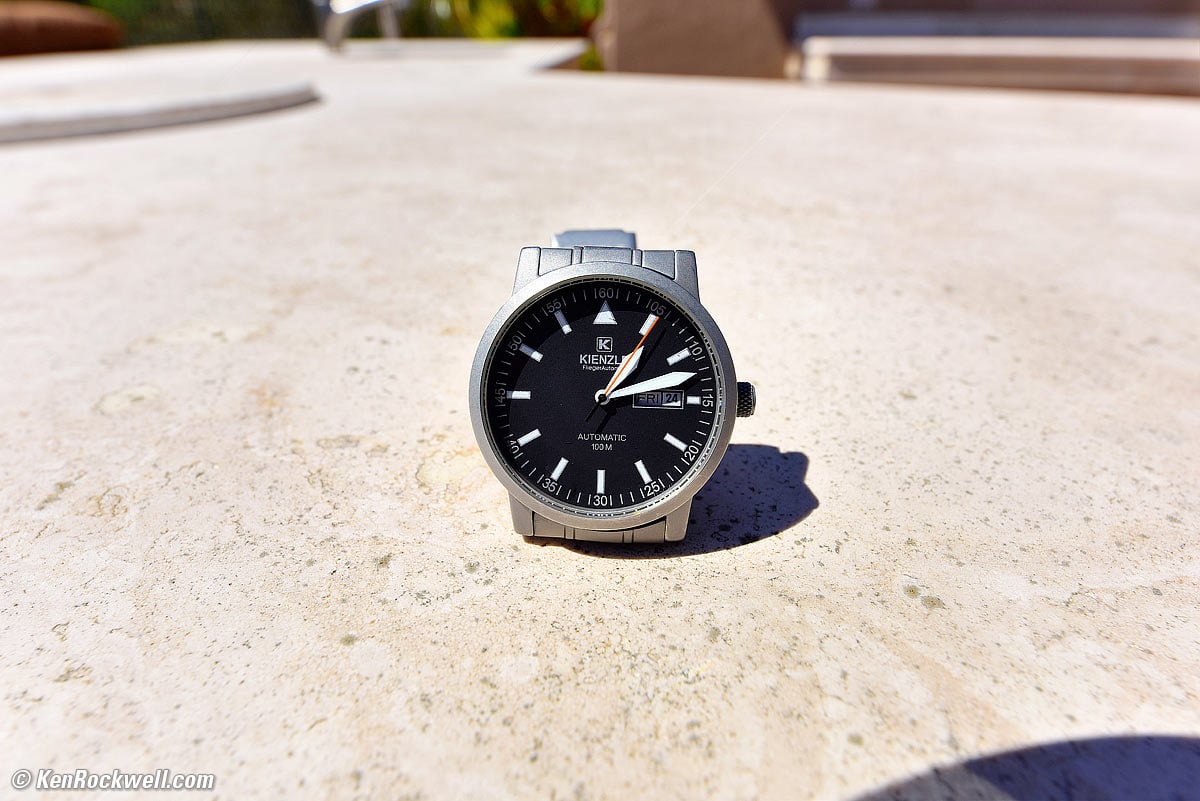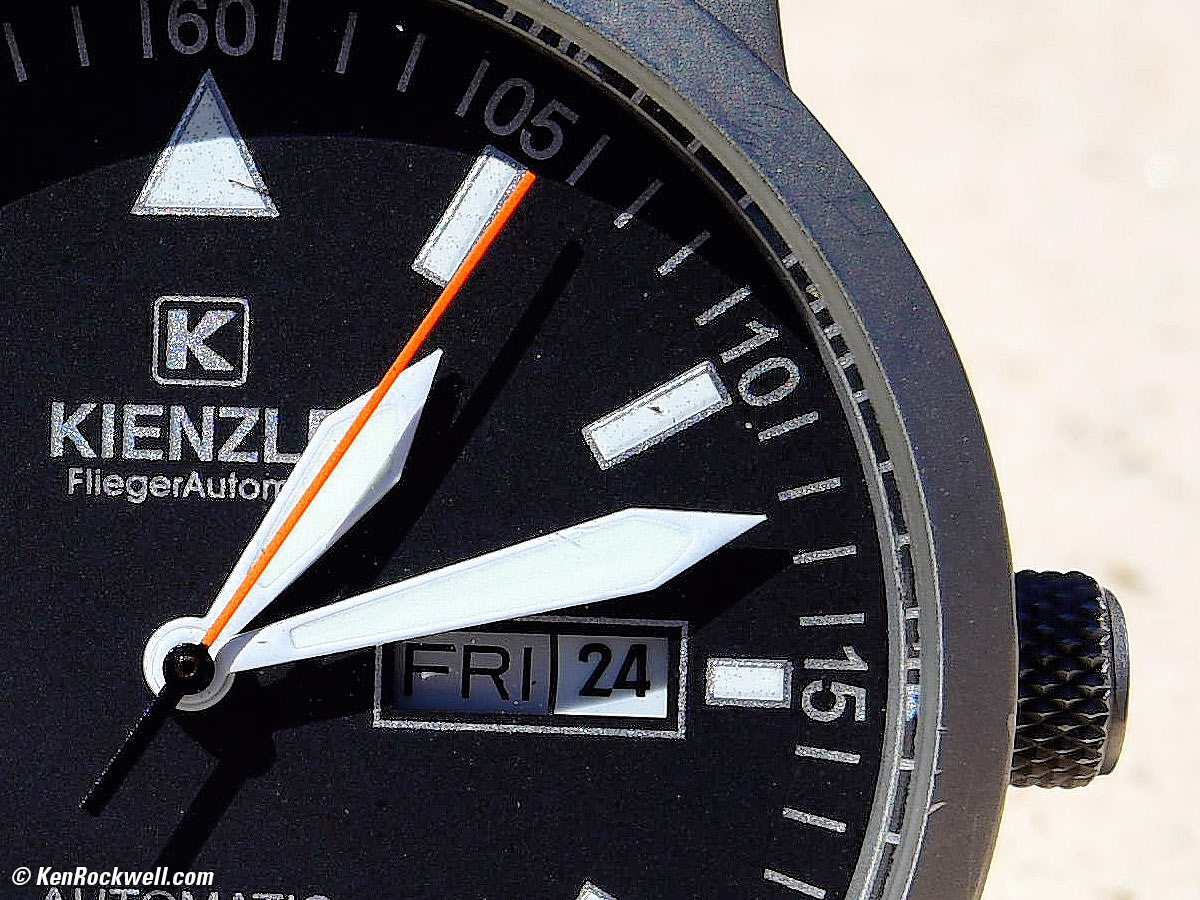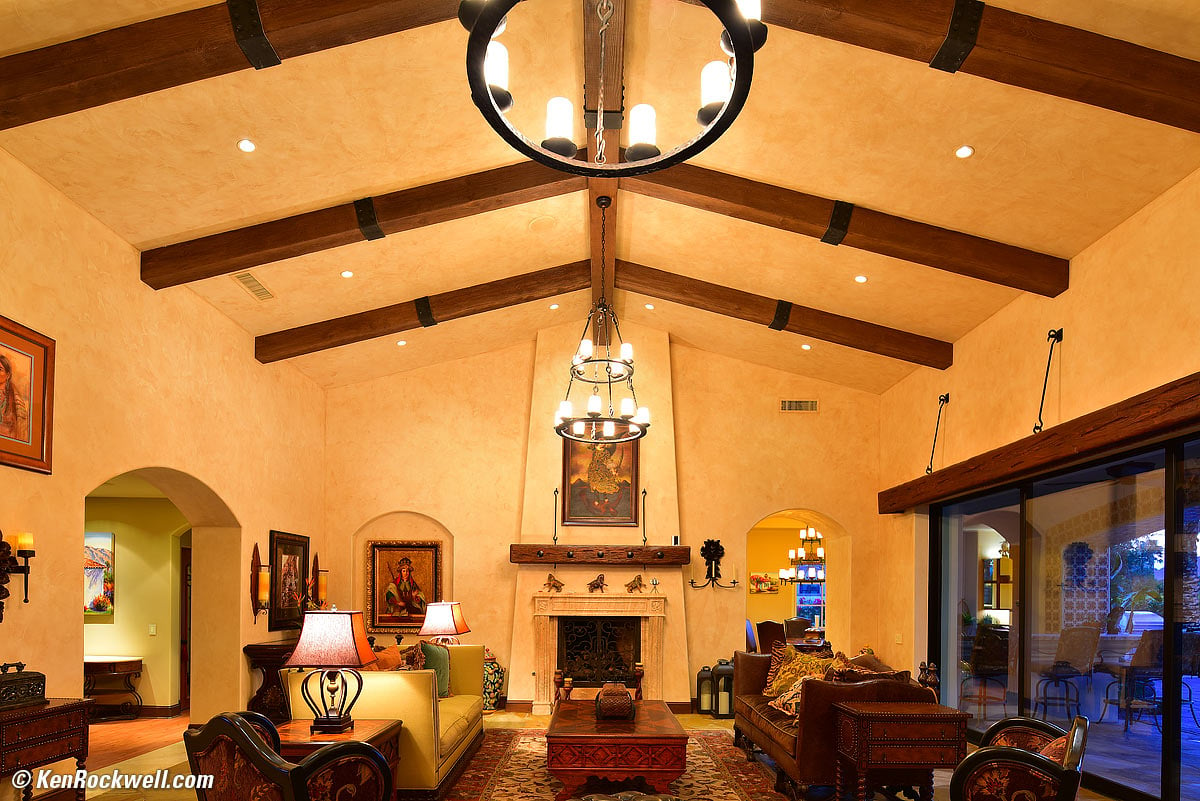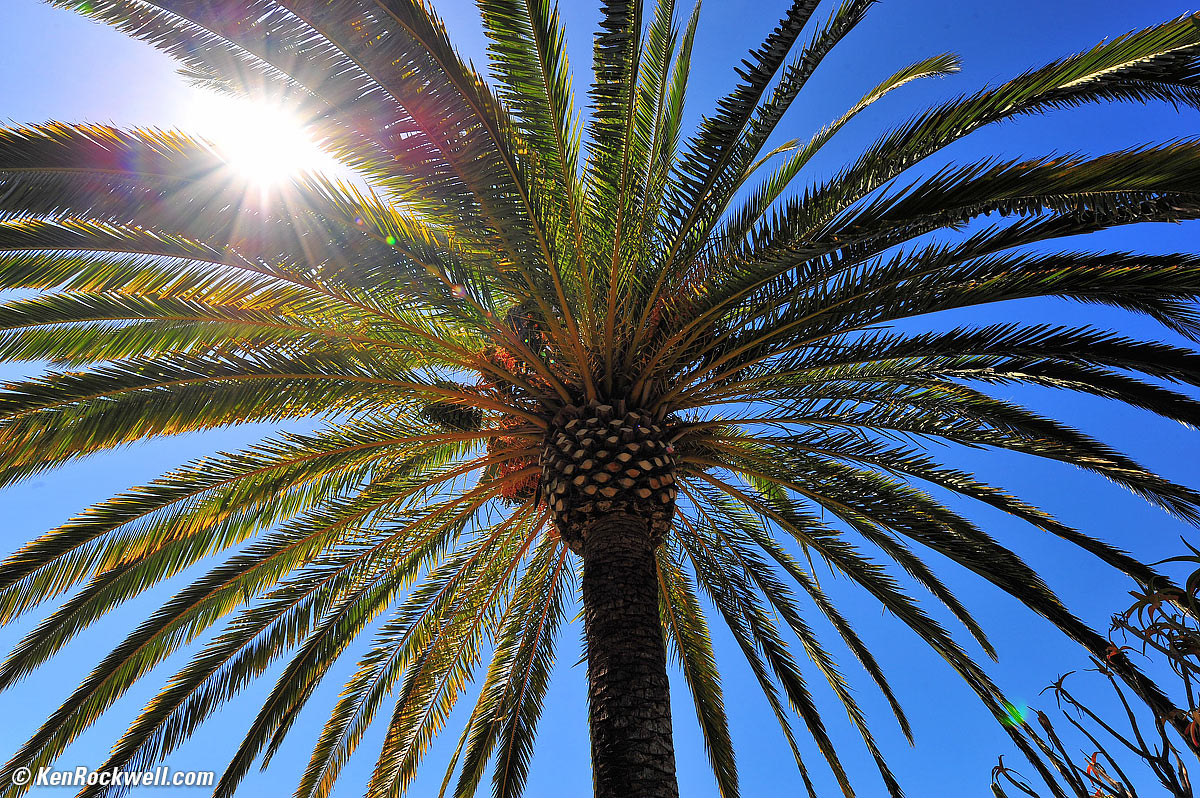Nikon 19mm PC-E
FX Tilt/Shift PC-NIKKOR f/4E
Top Sample Images Introduction Formats
Compatibility Specifications Accessories
USA Version Performance Compared
Nikon 19mm f/4E Tilt/Shift (31.2 oz./884 g, no usable filters, 0.8'/0.25m close-focus, about $3,400) bigger. I got mine at Adorama. I'd also get it at Amazon or at B&H.
This all-content, junk-free website's biggest source of support is when you use those or any of these links to my personally-approved sources when you get anything, regardless of the country in which you live. Nikon does not seal its boxes in any way, so never buy at retail or any other source not on my personally approved list since you'll have no way of knowing if you're missing accessories, getting a defective, damaged, returned, store demo or used camera. Buy only from the approved sources I use myself for the best prices, service, return policies and selection. Thanks for helping me help you! Ken.
April 2017 Nikon Reviews Nikon Lenses PC-E Lenses Nikon Flash All Reviews
See also: Why TIlt and Shift?
Sample Images
Top Sample Images Introduction Formats
Compatibility Specifications Accessories
USA Version Performance Compared
Shot with camera pointed up and unshifted lens. 5:11 PM, 28 February 2017, D810, f/8 at 1/250 at ISO 64. bigger.
Ahhh: shot with camera horizontal and lens shifted up — at dusk. Vertical lines stay vertical. 7:11 PM, 28 February 2017, D810, f/11 at 30 seconds at ISO 100. bigger or full resolution.
Shot with camera horizontal and lens shifted up. 6:54 PM, 28 February 2017, D810, f/11 at 4 seconds at ISO 100. bigger or full resolution.
Shot wide-open with camera horizontal and unshifted lens. Super-sharp wide-open if you don't need tilt. 6:56 PM, 28 February 2017, D810, f/4 at 1/2 at ISO 100. bigger or full resolution.
Shot with camera horizontal to keep vertical lines vertical, lens shifted down to frame image looking down on pillows, but not tilted. Limited depth-of-field. 7:02 PM, 28 February 2017, D810, f/4 at 1 second at ISO 100. bigger or camera-original © file.
Shot with camera horizontal to keep vertical lines vertical, lens shifted down to frame image looking down on pillows, and lens tilted down (forwards) to bring everything from the pillows to the far window in focus. 7:03 PM, 28 February 2017, D810, f/11 at 8 seconds at ISO 100. bigger or full resolution.
Introduction
Top Sample Images Introduction Formats
Compatibility Specifications Accessories
USA Version Performance Compared
|
I buy only from these approved sources. I can't vouch for ads below. |
Nikon 19mm Tilt/Shift allows us to tilt the lens, and therefore tilt the plane of perfect focus to match a wall, the ground, or any tabletop setup to give us perfect focus on almost any plane, with no need to stop down for depth of field. This lets us get much greater sharpness for landscapes, interiors and many other kinds of subjects not obtainable any other way; stopping down makes other lenses softer while the tilt function of this lens lets us get perfect focus on almost any plane we choose.
If you want the ground in perfect focus from inches in front of your camera all the way to infinity, just tilt the lens down, and voilà, perfect focus even wide open at f/4.
As a tilt/shift lens, we also can shift it, which is an entirely different adjustment from tilting. Shifting allows us to control or correct perspective distortion (converging lines) without any of the sharpness-robbing resampling or cropping involved correcting it later in software. With this lens we can keep straight lines straight and parallel without any digital trickery, and use our entire image.
The mechanics are so marvelously done that we can precisely and smoothly adjust all the movements, and they don't need any locks to hold our settings. This is a tilt-shift lens done right.
This is easily the best tilt & shift lens ever made by Nikon, and I've owned and been using them for decades. Nikon's first shift lenses (35mm PC and 28mm PC) only shifted; they couldn't tilt, which is more important today than shift.
Nikon's earlier PC-E lenses, the 24mm PC-E and 85mm PC-E, weren't able to adjust the angle between the axes of tilt and of shift, requiring a trip to the repair depot to change this. The 24mm PC-E and 85mm PC-E are both from 2008.
Today's 19mm PC-E is not only the widest and most useful focal length for a shift lens, it's also Nikon's first with two rotators so we can rotate the axes of shift and of tilt anyway we like.
This is a complex manual-focus lens best used on a tripod, with live view and manual exposure. Camera meters get messed up when you shift the lens, so just watch your LCD and set manually. Ditto for getting precise focus and tilt; just use magnified Live View for far better and easier adjustment than Ansel Adams ever had with his view cameras.
New
● Nikon's widest tilt/shift lens.
● Nikon's only lens that lets us set the axes of tilt and of shift separately.
Good
● Great optics.
● Almost limitless range of adjustment.
● Great mechanical quality.
● Made in Japan.
Bad
● No way to attach filters front or rear.
● Bulging front element is completely unprotected while in use. Even the slightest scratch on this ultrawide lens will affect your images, so it's easy to destroy this lens.
Missing
● No felt-lined metal front cap; just a cheap plastic made-in-China bayonet cap.
● No velvet-lined leather case; just a cheap sack.
Formats
Top Sample Images Introduction Formats
Compatibility Specifications Accessories
USA Version Performance Compared
Full Frame 24 × 36mm
This is a full frame (FX) lens, and I'll be reviewing it as such.
DX 16 × 24mm
It works great on DX cameras, too, on which you may make the usual inferences.
Medium Format
With at least a 67.3mm image circle, it should easily cover 33 × 44mm digital medium format's 55mm diagonal, and leave room for some shift.
In fact, an exotic full 645-format $50,000 digital back covers 41 × 55mm, or 68.6mm, so this lens almost covers even those sensors - but with no shifting.
Tilting done well won't require any shift, so you may get away with some tilting on 41x55mm if you are careful and can figure a way to mount it, or build a custom mount.
Of course any use on medium format will depend on your ability to adapt it mechanically, and will not work with the electronic diaphragm; you'll always be shooting at f/4.
Compatibility
Top Sample Images Introduction Formats
Compatibility Specifications Accessories
USA Version Performance Compared
It works on all FX Nikons, and works well on DX Nikons introduced since about 2007.
There are no physical restrictions on any movements with the D5, D4 series, D3 series, D810 series, D500 and Df. There may be some restrictions on some combinations of shift and rotation with other bodies.
It won't work properly on older DSLRs or any 35mm camera; they won't be able to work with the electronic diaphragm and will only shoot wide-open at f/4.
It won't work with any of the Nikon 1 series (even with the FT1 Mount Adapter) or Pronea cameras — but who cares?
It mounts just fine on my FE, F3HP and F6. Metering works well, unshifted, but of course only shoots at f/4. If you don't mind only shooting at f/4, you're OK.
It won't mount at all on my FM3a, F4, FA, or F2AS. These cameras' ADR (Aperture-Direct Readout) optics interfere with the larger-diameter base of the lens.
See Nikon Lens Compatibility for more.
Specifications
Top Sample Images Introduction Formats
Compatibility Specifications Accessories
USA Version Performance Compared
Bottom, Nikon 19mm f/4E Tilt/Shift. bigger.
Name
Nikon calls this the Nikon PC NIKKOR 19mm f/4E ED Aspherical N
PC: Perspective Control.
NIKKOR: Nikon's brand name for all their lenses.
E: Electronic diaphragm. Silent operation, but only works with cameras introduced since about 2007.
ED: Magic Extra-low Dispersion glass for reduced secondary chromatic aberration.
Aspherical: Specially curved glass elements for even sharper pictures.
N: Nano Crystal Coat, a magic anti-reflection coating that has a variable index of refraction that's far more effective than multicoating.
Also has:
RF: Rear focusing; nothing moves externally as focused except the rear group.
Optics
Nikon 19mm f/4 E ED internal construction Aspherical and ED Elements.
17 elements in 13 groups.
2 aspherical elements.
3 extra low dispersion (ED) elements.
Nano coating: on at least one surface.
Rear section focusing; nothing moves externally as focused except the rear elements that move together inside the barrel.
Fluorine coating on front surface to repel crud.
Maximum Tilt
± 7.5º
Maximum Shift
± 12 mm.
Image Circle Diameter
67.3mm, since it covers 24x36mm shifted 12mm along the diagonal.
Diaphragm
Front, Nikon 19mm f/4E at f/4 (electronic diaphragm not visible). bigger.
9 rounded blades.
Stops down to f/32.
Focal Length
19mm.
When used on a DX camera, it sees the same angle of view as a 29 mm lens sees when used on a 35mm or full-frame camera.
When used on full-frame, it sees about the same angle-of-view as a 31mm lens sees on a 6 × 9 cm camera. In this case, it sees the equivalent of a 31mm lens with 19mm of shift on 6 × 9.
When used on full-frame, it sees about the same angle-of-view as a 75mm lens sees on a 4 × 5" camera or a 150mm lens sees on an 8 × 10" camera. In these cases, it sees the equivalent of a 75mm lens with 47mm of shift on 4 × 5, and a 150mm lens with 95mm of shift on an 8 × 10.
See also Crop Factor.
Angle of View
97º diagonal (unshifted) on FX.
73º diagonal (unshifted) on DX.
When shifted 12mm in the diagonal direction of a 24 × 36mm frame, it's covering 121º diagonal on FX! This is the same angle as seen with an unshifted 12mm lens on full-frame.
Autofocus
NONE.
This is a manual focus lens.
Close Focus
0.8 feet (0.25 meters).
Maximum Reproduction Ratio
1:5.56 (0.18 ×).
Hood
NONE.
Filters
NONE.
Caps
Nikon 19mm f/4 PC-E with caps. bigger.
LC-K101 bayonet front cap. Don't lose it; you'll probably damage your lens putting it in your case and the replacement cap is $70!
LF-4 rear cap.
Case
CL-1120 sack included.
Size
3.50" maximum diameter × 4.88" extension from flange.
89 mm maximum diameter × 124 mm extension from flange.
Weight
31.185 oz. (884.1 g) actual measured weight, lens only.
33.740 oz. (956.55 g) actual measured weight, lens & caps.
Nikon specifies 31.3 oz. (885 g).
Announced
19 October 2016.
Included
Lens.
LC-K101 bayonet front cap. Don't lose it; you'll probably damage your lens putting it in your case and the replacement cap is $70!
LF-4 rear cap.
CL-1120 sack.
Nikon Model Number
20065.
Quality
Lens made in Japan.
Front LC-K101 cap made in China.
Price, USA
$3,400, March ~ April 2017.
Box, Nikon 19mm f/4E Tilt/Shift. bigger.
Optional Accessories
Top Sample Images Introduction Formats
Compatibility Specifications Accessories
USA Version Performance Compared
None.
It comes included with the LC-K101 bayonet front cap, LF-4 rear cap and CL-1120 carry sack.
There are no hoods or filters available for it.
Getting a Legal USA Version
(for USA only)
Top Sample Images Introduction Formats
Compatibility Specifications Accessories
USA Version Performance Compared
A legally imported USA version has a warranty card from Nikon USA:
Nikon USA Warranty Card. bigger.
The serial number on the card must match the serial number on the bottom of the lens, or you have no warranty. The serial number on the box should also match.
If you didn't get this card or the numbers don't match, you got ripped off with a gray market version from another country. This is why I never buy anyplace other than from my personally approved sources. You just can't take the chance of buying elsewhere, especially at any retail store, because non-USA versions have no warranty, and you won't even be able to get firmware or service for it — even if you're willing to pay out-of-pocket for it when you need it!
If a gray market version saves you $1,000 it may be worth it, but for $200 or less I wouldn't risk having no warranty or support.
Always be sure to check yours while you can still return it, or just don't buy from unapproved sources or at retail so you'll be able to have your camera serviced and get free updated firmware as needed.
Get yours from the same places I do and you won't have a problem, but if you take the risk of getting yours elsewhere, be sure to check everything while you still can return it.
Performance
Top Sample Images Introduction Formats
Compatibility Specifications Accessories
USA Version Performance Compared
Overall Autofocus Manual Focus Bokeh
Distortion Ergonomics Falloff Filters
Flare & Ghosts Lateral Color Fringes
Macro Mechanics Sharpness Sunstars
Overall
The Nikon 19mm tilt-shift is optically super-sharp, but that's not why we buy this lens. The 16-35mm VR is also super-sharp, and a third the price.
While the ability to remove keystone and distortion effects in-camera by shifting are nice, we can correct these in Photoshop, even from film, so that's also not the real reason we buy this lens — but it is a nice feature that helps increase sharpness slightly since we don't have to mush pixels around later.
Tilt is the real reason for this lens. When we tilt a lens we also tilt the plane of perfect focus. If we want a field in focus right up to inches in front of the lens, easy: just tilt the lens forward, and the plane of perfect focus tilts in the same direction. Instead of being parallel to the image plane, we can move the plane of perfect focus to be the plane of a wall, table-top setup or landscape. Here are two images shot wide-open at f/4. Click any of these images for the camera-original JPG file:
While these may not look that different as shown small on this web page, let's look at crops from the top and then from the bottom. With the untilted lens, only the middle is in focus, while the top and bottom are not. With the tilted lens, I've tilted the plane of perfect focus to lie on the lawn, giving us perfect focus from inches all the way out to infinity behind the fence:
Crop from the top. bigger. |
Crop from the top. bigger. |
And here are crops from the bottom of each image:
Crop from the bottom. bigger. |
Crop from the bottom. bigger. |
Ha! Even at f/4, it's all in perfect focus with the lens tilted.
Why not just use a regular lens and stop all the way down to f/32? Because f/32 leads to soft images from diffraction. Diffraction is what makes things softer when we squint; peeping through tiny holes makes things soft.
While looking at a web-sized image may look OK shot at f/32 (click any for the original file shot at f/32):
Enlarging it shows how much softer an image is when dulled by diffraction at f/32, and these are from the perfectly in-focus center sections:
Crop from the center at f/32. bigger. |
Crop from the center at f/4. bigger. |
In actual shooting I'd tilt the lens and stop down to f/11. While the plane of perfect focus lies on the grass, additional depth-of-field lets things above or below that plane be sharper. Here's how it looks tilted at f/11 (click image for the original f/11 file):
Autofocus
There is NO autofocus.
Manual Focus
Manual focus is easy, just turn the ring.
The most precise way to focus is to use magnified Live View.
Bokeh
Bokeh, the feel or quality of out-of-focus areas as opposed to how far out of focus they are, is pretty good — but the whole point of this lens is to get everything in focus.
Seeing how it's very difficult to get things out of focus with a 19mm lens, I wouldn't be too impressed by its very good bokeh.
A nifty trick not shown here is that you can can tilt the lens to put some areas deliberately more out-of-focus just as well as you can pull them into focus, but if this is your plan, you're better off using the 85mm PCE since longer lenses put things further out of focus than ultrawides like this.
Davis 6250 weather station, March 2017. bigger or camera-original © file to explore on your computer (mobile devices rarely display full resolutions images properly).
Distortion
This lens has a little bit of distortion, which is this lens' weakest point.
The distortion is nearly invisible, but seeing how those of us who buy this are probably doing architectural work and worried about distortion, it's sad that it may occasionally require some correction.
Worse, once you shift the lens, then all the usual ways we correct distortion go out the window, since we will now have to go out of our way to correct distortion not from the center as all software assumes, but figure out a way to correct distortion from some arbitrary point in the image where the center of the lens happens to lie.
If you know how far it was shifted, you can increase the canvas size in Photoshop to put the optical center of the lens in the middle of the canvas and then run the lens correction filter the usual way.
My D810 has no automatic correction for this lens, and even if it did, those wouldn't apply once the lens is shifted.
I would use a factor of +1.5 in Photoshop's Lens Correction Filter with an unshifted lens. The result is still a tiny but wavy after correction. I see this same amount of distortion at either 3' (1m) or 10' (3m).
If shifted 12mm, I would use a factor of +2.3 to correct it, but that's after expanding the canvas accordingly.
Good luck! The good news is that it's not obvious unless you're really looking for it.
Ergonomics
Nikon 19mm f/4E tilted 7.5º and shifted 12mm. bigger.
For such a complex lens, it handles magnificently well.
All the adjustments and interlocks look, work and feel exactly as we expect. It's easy to adjust the lens into all sorts of tortuous settings, and it doesn't drift.
There are no restrictions on what goes in what direction; older lenses required a trip to a service department to swap axes of tilt and shift, while this lens has two rotators to let us do whatever we want.
There's a zero click-stop for tilt, but not for shift.
The rear rotator, which selects the direction in which the lens shifts, rotates continuously through 180º and has reference clicks at each 30º.
The front rotator sets the offset between the direction of shift and the axis of tilt. It's new and what you used to have to send the lens in for service to adjust. It rotates continuously through 90º and has a reference click at 45º.
Focus has exactly the right drag. It slides with a fingertip, and stays put.
The plastic cap bayonets on and off, with a click-lock.
The one bad thing, and it's a biggie, is there there is NO front element protection. It's easy to bop the lens on just about anything as you move around, and if you do, you've probably trashed your lens.
Other than that, bravo!
Falloff & Vignetting
Falloff on FX and 35mm is minor. There is some mild and gradual falloff at f/4 which may be used for creative effect, and there's none stopped down.
It won't be an issue at all on DX (see crop factor).
Even shifted all the way, there's no vignetting:
Full-frame vertical shot with 12mm of vertical shift, and no falloff at f/8! bigger or camera-original file.
This is impressive; unlike older shift lenses that couldn't shift all the way to ± 12mm except along the short dimension of the image, we now can shift ± 12mm in any direction.
Yes, the sky is lighter at the horizon and darker at the top, but that's the natural polarization of the sky at this time of the day, not this lens. The corners aren't any darker than the rest of the image, even with this insane amount of shift.
Bravo!
Filters, use with
Forget it. There's no way to attach them anywhere unless you get creative with gels and tape on the rear, or crazy home-made rigs on the front.
Flare & Ghosts
I see no flare, and only a very few tiny ghosts.
See samples at Sunstars.
Lateral Color Fringes
I see only the tiniest bit of green/magenta lateral color, and then only in the farthest corners only visible when extreme shift is used.
This is excellent!
Macro
It gets reasonably close:
Kienzle Flieger Automat 800/2843, March 2017. Nikon D810, f/8 at 1/250 at Auto ISO 100. bigger or camera-original © file to explore on your computer (mobile devices rarely display full resolution images properly).
1,200 x 900 pixel crop from above 36 MP image. bigger or camera-original © file to explore on your computer (mobile devices rarely display full resolution images properly).
If this crop is about 6" (15cm) wide on your screen, then the complete image printed at this same extreme magnification would be about 25 x 37" (66 x 100cm). In this case, you're seeing the texture of the silver paint on the watch face.
If this crop is about 12" (30cm) wide on your screen, then the complete image printed at this same extreme magnification would be about 50 x 75" (1.3 x 2 meters). In this case, you're seeing the texture of the silver paint on the watch face.
Mechanical Quality
Rear, Nikon 19mm f/4E Tilt/Shift. bigger.
This is a very well made lens. It's a real made-in-Japan mostly metal lens for a change.
Front Cap
Hard Chinese plastic.
Front Bumper
NONE.
Filter Threads
NONE.
Cap Bayonet Mount
Plastic.
Gold ED Band
18 karat gold filled.
Front Barrel (between filter and focus ring)
Plastic.
Focus Ring
Rubber-covered metal.
Mid Barrel (ahead of swing mechanism)
Metal.
Tilt and Shift Mechanisms
All metal.
Rotators
All metal.
Adjustment knobs
All metal.
Rear Barrel
Metal.
Identity
14 karat gold-filled debossed metal plate behind focus ring, also white paint on bottom of barrel.
Internals
Seem like all metal!
Moisture Seal at Mount
Yes.
Mount
Dull chromed metal.
Markings
Paint.
Serial Number
Sticker glued into recess in the bottom of the lens barrel.
Date Code
None found.
Noises When Shaken
Moderate clunking.
Made in
Japan.
Sharpness
It's an ultra-sharp lens edge to edge. The only limitations will be your skill as a photographer, and how well you can adjust a tilt-shift lens.
Shot wide-open at f/4 with camera horizontal and lens shifted up. 6:54 PM, 28 February 2017, D810, f/4 at 1 second at ISO 100. bigger or camera-original file.
So long as it's in focus, it's ultra sharp even in the corners at f/4.
Nikon's MTF charts at 10 cyc/mm and 30 cyc/mm.
Sunstars
The Nikon 19mm only makes Sunstars at its smallest apertures.
Click any to enlarge:
At f/4. The vertical smear on the sun is interline transfer smear in the D810's CCD since I was shooting the sun at f/4 in the middle of the day; it overloaded the sensor. bigger.
At f/5.6. The vertical smear on the sun is interline transfer smear in the D810's CCD since I was shooting the sun at f/5.6 in the middle of the day; it overloaded the sensor. bigger.
At f/8. bigger.
At f/11. bigger.
At f/16. bigger.
At f/22. bigger.
At f/32. bigger.
Compared
Top Sample Images Introduction Formats
Compatibility Specifications Accessories
USA Version Performance Compared
There's no real comparison.
Nikon's other PCE lenses lack the flexibility of hand-adjusting the axes of tilt and shift independently, but even if they did, they are of completely different focal lengths for different applications.
Canon's 17mm TCE is a gem, both wider and much less expensive, and I suspect at least as good optically. They don't interchange, so this is academic. Whichever is best depends on which brand of camera you're shooting.
Usage
Top Sample Images Introduction Formats
Compatibility Specifications Accessories
USA Version Performance Compared
See also: Why TIlt and Shift?
Danger
There is NO front element protection. It's easy to bop the lens on just about anything as you move around, and if you do, you've probably trashed your lens. Be very careful with how you move and use this lens. I don't move it unless its cap is on.
Tripod
Use a tripod; the adjustments are precise enough that it makes no sense to try to hand-hold once shifted. Once tilted, minor changes in direction from hand-holding will completely lose focus!
Exposure
Once shifted, use manual exposure, and don't believe the camera's meter. Just guess until it looks right on your LCD or histogram — easy.
Composition
Don't forget Live View to see what you're doing; normal viewfinders get much darker as the lens is tilted or shifted.
Focus
Use magnified Live View for setting focus.
There's no infinity stop, to allow us flexibility when tilted.
Shift
We use shift to keep parallel lines parallel, and vertical lines vertical.
If the camera's sensor stays parallel to the subject and straight up and down, then the subject will be shown straight. We use lens shift to prevent us from having to tilt the camera to frame our picture. Tilting the camera instead of shifting the lens is what leads to converging lines that make buildings look like they're falling backwards.
To set shift, be sure the camera is level, and only then shift the lens to frame your photo — not the other way around.
Tilt
To set tilt, first frame your image (and shift if needed).
Set the focus ring while using magnified Live View to make the middle of your image sharp.
Now look at an edge of the image in magnified Live View (top or bottom if tilting up or down, and left or right if swinging left or right), and carefully tilt or swing the lens in the direction you'd like to move the plane of focus until that edge or extremity is in perfect focus. Look at the other edge and fine-tune the focus. Check the center and all around, and fine-tune the focus ring (adjusts center) and tilt (adjusts edges) as needed.
Hint: The planes of perfect subject focus, the plane of the lens itself and the image plane always meet along the same line in space. A guy named Scheimpflug first documented this. Normally all three planes in most lenses are parallel so they meet at infinity, but if you tilt the lens just a little forward so its imaginary plane intersects the imaginary image plane at the ground under your camera, BINGO!, now the plane of perfect subject focus extends from the ground underneath you out to infinity. See Steve Simmons' Using the View Camera and Ansel Adams' The Camera for the details, or just pay attention as you tilt the lens and look around the image with magnified Live View.
Recommendations
Top Sample Images Introduction Formats
Compatibility Specifications Accessories
USA Version Performance Compared
Tilt for Perfect Near-Far Focus
Tilting is for when we need everything to be in perfect focus from near to far. If you want everything on a plane from inches to infinity to be in perfect focus without needing to stop down, this is the only way to do it.
This is why the masters have shot view cameras since the invention of photography almost 200 years ago through today: tilting a lens, image sensor or film is the only way to bring near and far into perfect focus at the same time. It's not the camera resolution or image size that makes tilt lenses and view cameras so special; it's their ability to bring everything into perfect focus that lets these images be so sharp. Stopping down doesn't work as well due to diffraction, and often the difference from near to far is so great that even without diffraction other lenses that can't tilt can't stop down enough.
We can correct perspective in software, but we can't fix focus after we shoot. We still need tilt lenses for perfect near-far focus.
Shift for Perspective Control
For perspective correction, shifting the lens allows somewhat sharper results than correcting perspective and converging lines later in software, but I don't know that this benefit justifies such a specialized lens. For real estate listings, I prefer to use a wider lens and correct later as needed.
Tripods & Heads
This lens is born for tilting and shifting, and tilting and shifting make little sense when hand-held since you can't maintain the exact framing.
I always use my Bogen Manfrotto 3275 410 Geared Head because it has three precision worm-gear driven adjustment for pan, tilt and roll, allowing precise and exact framing and composition demanded by a lens like this.
This lens needs perfect leveling, and this head lets me do this easily. Other heads that let me unlock, move and relock them don't have anything like the fine-tuned control this head offers.
This head also never flops free unless you deliberately unlock the worm gear drive, so you don't have to worry about the camera flopping down and scratching the lens on something.
If you are spending over $3,000 on this marvelous lens, you need this $220 head. I've been using my 410 Geared Head for about 20 years; they never wear out.
Care
Watch the front element! It's easy to damage, and even a minor scratch will appear in your photos.
Getting a Good Sample
I got mine at Adorama. I'd also get it at Amazon or at B&H.
This all-content, junk-free website's biggest source of support is when you use those or any of these links to approved sources when you get anything, regardless of the country in which you live. Nikon does not seal its boxes in any way, so never buy at retail or any other source not on my personally approved list since you'll have no way of knowing if you're missing accessories, getting a defective, damaged, returned, store demo or used lens. Especially with an exotic and easily damaged lens like this, only a nut would even consider getting one at retail since everyone will have played with it and possibly damaged the front element before you buy it. I use the stores I do because they ship from secure remote warehouses where no one gets to touch your new lens before you do. Buy only from the approved sources I use myself for the best prices, service, undamaged products, return policies and selection.
Thanks for helping me help you!
Ken, Mrs. Rockwell, Ryan and Katie.
More Information
Top Sample Images Introduction Formats
Compatibility Specifications Accessories
USA Version Performance Compared
© Ken Rockwell. All rights reserved. Tous droits réservés. Alle Rechte vorbehalten.
Help Me Help You
I support my growing family through this website, as crazy as it might seem.
The biggest help is when you use any of these links when you get anything. It costs you nothing, and is this site's, and thus my family's, biggest source of support. These places always have the best prices and service, which is why I've used them since before this website existed. I recommend them all personally.
If you find this page as helpful as a book you might have had to buy or a workshop you may have had to take, feel free to help me continue helping everyone.
If you've gotten your gear through one of my links or helped otherwise, you're family. It's great people like you who allow me to keep adding to this site full-time. Thanks!
If you haven't helped yet, please do, and consider helping me with a gift of $5.00.
As this page is copyrighted and formally registered, it is unlawful to make copies, especially in the form of printouts for personal use. If you wish to make a printout for personal use, you are granted one-time permission only if you PayPal me $5.00 per printout or part thereof. Thank you!
Thanks for reading!
Mr. & Mrs. Ken Rockwell, Ryan and Katie.

